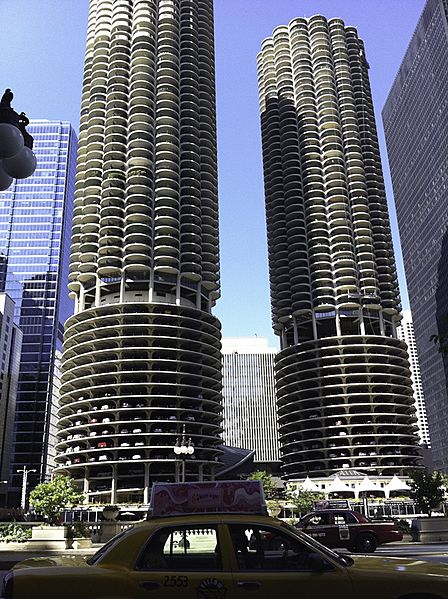Image: Marina City, Chicago

Description: Marina City is a mixed-use residential/commercial building complex occupying an entire city block on State Street in Chicago, Illinois. It lies on the north bank of the Chicago River, directly across from Chicago's Loop district. The complex consists of two corncob-shaped 65-story (including 5-story elevator & physical plant penthouse), 587 foot (179 m) tall residential towers, a saddle-shaped auditorium building, and a mid-rise hotel building all contained on a raised platform cantilevered over defunct railroad tracks adjacent to the river. Beneath the raised platform at river level is a small marina for pleasure craft. The Marina City complex was designed in 1959 by architect Bertrand Goldberg and completed in 1964 at a cost of $36 million financed to a large extent by the union of building janitors and elevator operators, who sought to reverse the pattern of white flight from the city's downtown area. When finished, the two towers were both the tallest residential buildings and the tallest reinforced concrete structures in the world. The complex was billed as a city within a city, featuring numerous on-site facilities including a theatre, gym, swimming pool, ice rink, bowling alley, several stores and restaurants, and of course, a marina. Marina City was built by general contractor James McHugh Construction Co. which subsequently built Water Tower Place in 1976 and Trump Tower in 2009, both also tallest reinforced concrete structures in the world at the time. Local television station WFLD, (FOX Channel 32) operated from Marina City for eighteen years until they were bought by Metromedia. ABC, NBC and CBS had their transmitters atop Marina City until the John Hancock (and later Sears) Tower was built. Marina City was the first urban post-war high-rise residential complex in the United States and is widely credited with beginning the residential renaissance of American inner cities. Its model of mixed residential and office uses and high-rise towers with a base of parking has become a primary model for urban development in the United States, and has been widely copied throughout downtown Chicago. Marina City construction employed the first tower crane used in the United States. The two towers contain identical floor plans. The bottom 19 floors form an exposed spiral parking ramp operated by valet with 896 parking spaces per building. The 20th floor of each contains a laundry room with panoramic views of the Loop, while floors 21 through 60 contain apartments (450 per tower). A 360-degree open-air roof deck lies on the 61st and top story. The buildings are accessed from separate lobbies that share a common below-grade mezzanine level as well as ground-level plaza entrances beside the House of Blues. Originally rental apartments, the complex converted to condominiums in 1977. The towers lie on the north bank of the Chicago River. Marina City apartments are unique in containing almost no interior right angles. On each residential floor, a circular hallway surrounds the elevator core, which is 32 feet (10 m) in diameter, with 16 pie-shaped wedges arrayed around the hallway. Apartments are composed of these triangular wedges. Bathrooms and kitchens are located nearer to the point of each wedge, towards the inside of the building. Living areas occupy the outermost areas of each wedge. Each wedge terminates in a 175-square-foot (16.3 square meter) semi-circular balcony, separated from living areas by a floor-to-ceiling window wall. Because of this arrangement, every single living room and bedroom in Marina City has a balcony. The apartments are also unusual in that they function solely on electricity; neither natural gas nor propane serves any function. The apartments are not provided with hot water, air conditioning, or heat from a central source, as was the common practice at the time the towers were built. Instead, each unit contains individual water heaters, heating and cooling units, and electric stoves; residents pay individually for the electricity needed to run these appliances. This may have been a financial decision on the part of the building owners; at the time these towers were constructed, local electric utility Commonwealth Edison provided expensive building transformers at little or no charge provided the buildings were made all-electric. In addition, the residential towers are noted for the high speed of their elevators. It takes approximately 35 seconds to travel from the lower-level lobby to the 61st-floor roofdecks.[citation needed] The towers were awarded a prize by the New York Chapter of the American Institute of Architects in 1965 for their innovation. The corn-cob appearance of the towers is said to have inspired a similar design for the Corinthian Tower in New York. In 2007, the condominium board controversially claimed to own common law copyright and trademark rights to the name and image of the buildings, although they do not own the parking garage portion of the buildings located below the 20th floor. They claim that any commercial use (such as in movies or Web sites) of pictures of the buildings or of the name "Marina City" without permission is a violation of their intellectual property rights.
Title: Marina City, Chicago
Credit: Marina City, Chicago : i’ve always loved these towers Uploaded by Gary Dee
Author: John Manoogian III from California
Usage Terms: Creative Commons Attribution-Share Alike 2.0
License: CC BY-SA 2.0
License Link: http://creativecommons.org/licenses/by-sa/2.0
Attribution Required?: Yes
Image usage
The following page links to this image:

